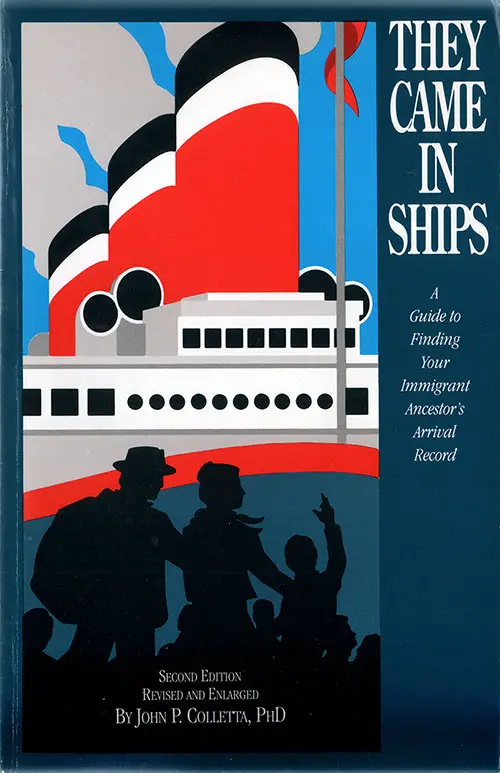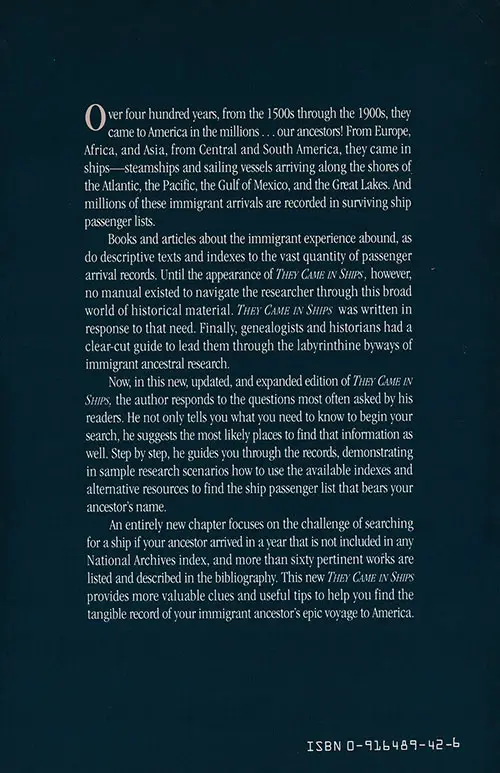They Came in Ships, 2nd Edition

Front Cover, They Came in Ships: A Guide to Finding Your Immigrant Ancestor's Arrival Record, Second Edition, Revised and Enlarged by John P, Colletta, Ph.D., 1993. GGA Image ID # 204cdfddf1
Publisher Description
Chances are excellent that your ancestors came to America from somewhere like England, Spain, Germany, China, or Africa. Can you imagine how they felt as they left their homes, what they left behind? Do you want to know? Where can I even start looking for the details? Author and genealogist John P. Colletta prepares you to undertake the search. Before beginning, he tells you what fundamental facts you need to know about your immigrant ancestors. He suggests where you may find that information.
Contents
Preface
Introduction: What Passenger Lists Tell You about Your Ancestors
- Biographical and Genealogical Information
- The Overseas Link
- The Migration Story
Chapter 1 : What You Need to Know and Where to Find It
First You Must Know the Passenger's
- Full, Original Name
- Approximate Age at Arrival
- Approximate Date of Arrival
Where Can You Find This Information?
- Oral Family Tradition
- Personal and Family Documents
- Civil and Church Records
- Published Genealogies and Local Histories
The Two Major Periods of Ship Passenger Lists
- 1565-1819
- 1820-1954
Chapter 2: Passenger Lists of 1565-1819
- Indexes to Published Arrival Lists
- Bibliography of Published Ship Passenger Lists
- If Your Ancestor Was a Slave
- Learning More about Your Ancestors Ship
Chapter 3: Passenger Lists of 1820-1954
- Customs Passenger Lists (1820-ca. 1891)
- Immigration Passenger Lists (1891 -1954)
- Births and Deaths at Sea, Stowaways, and Other Information
- National Archives Indexes
- Alphabetical Indexes
- Soundex Indexes
- Post-1910 New York Arrivals
- Book Indexes
- Problems with the National Archives Indexes—and Solutions
Chapter 4: Searching in Unindexed Years
- Published Indexes
- Microfilm M1066—for New York Arrivals
- Sailing Vessels and Steamships
- The Morton-Allan Directory—for New York, Baltimore, Boston, and Philadelphia Arrivals
- Microfilm M334—for Boston and New Orleans Arrivals
- Emigration Lists
- Determining Your Ancestor's Probable Port of Departure
- Locating Emigration Lists
- Bremen Passenger Lists
- Hamburg Passenger Lists
- European Passport Records
Other Resources and Information of Potential Value
- Crew Lists
- Lists of Chinese Passengers
- Newspaper of the Port of Entry
- Immigration via Canada, 1895-1954
- Immigration Laws of 1921 and 1924
- Obtaining a Picture of Your Ancestors Ship
- Sailing Vessels and Steamships
- The Steamship Historical Society of America
Conclusion: A Word about Ellis Island
Select Bibliography

Back Cover, They Came in Ships: A Guide to Finding Your Ancestor's Arrival Record by John P. Colletta, Ph.D., 1993. GGA Image ID # 204d1a4070
From the Back Cover
Over four hundred years, from the 1500s through the 1900s, They came to America in the millions... our ancestors From Europe. Africa and Asia, from Central and South America, came in ships—steamships and sailing vessels arriving along the shores of the Atlantic, the Pacific, the Gulf of Mexico, and the Great Lakes. Millions of these immigrant arrivals are recorded in surviving ship passenger lists.
Books and articles about the immigrant experience abound, as do descriptive texts and indexes to the vast quantity of passenger arrival records. Until the appearance of They Came in Ships, however, no manual existed to navigate the researcher through this broad world of historical material. They Came in Ships was written in response to that need. Finally, genealogists and historians had a clear-cut guide to lead them through the labyrinthine byways of immigrant ancestral research.
Now. in this new, updated, and expanded edition of They Came in Ships, the author responds to the questions most often asked by his readers; he not only tells you what you need to know to begin your search, but he suggests the most likely places to find that information as well. Step by step, he guides you through the records, demonstrating in sample research scenarios how to use the available indexes and alternative resources to find the ship passenger list that bears your ancestor's name.
An entirely new chapter focuses on the challenge of searching for a ship if your ancestor arrived in a year that is not included in any National Archives index. More than sixty pertinent works are listed and described in the bibliography. This new They Came in Ships provides valuable clues and helpful tips to help you find the tangible record of your immigrant ancestor's epic voyage to America.
They Came in Ships, Revisited by the GG Archives
Initially published in 1989 with the Second Edition, Revised and Enlarged published in 1993, the book needed to age better. Ancestry.com launched in 1996 and changed dramatically since then with a proliferation of websites devoted to genealogy, family history, immigration, and related topics.
While the book may seem outdated, the principles haven't changed. People who try to skip steps in their research will often spend the greatest amount of time hunting down facts as they cross many roads and oceans that their ancestors traveled upon.
The third edition, published in 2002, provides insight into the technology side of genealogy research around page 82. Unfortunately, 20+ years have passed, the websites may have changed, and the technology and databases have improved dramatically in those 20 years, making the third edition. Given the time that has passed, it was likely the last edition in that series to be published.
Because of the rapid changes in data, technology, search engines, and websites, your best use of time is researching online. Ancestry.com, Fold3, and similar sites can often be accessed free of charge at local libraries. Websites like the GG Archives are ephemera archives with materials that can augment your research and provide images, brochures, examples of passage contracts, ship schedules, rate schedules for the passage, menus, landing cards, postcards, and much more.
About The Author
John Philip Colletta is one of America's most popular genealogical lecturers. He conducts workshops for the National Archives, teaches courses for the Smithsonian Institution, and lectures nationally. He is also on the faculty of three genealogical institutes held annually.
Library of Congress Catalog Listing
- Personal name: Colletta, John Philip, 1949-
- Main title: They came in ships / by John Philip Colletta.
- Published/Created: Salt Lake City, UT: Ancestry Pub., c1989.
- Description: 65 p.: ill.; 22 cm.
- ISBN: 0916489426
- LC Classification: CS49 .C63 1989
- LC Subjects: Ships--United States--Passenger lists--Handbooks, manuals, etc. United States--Genealogy--Handbooks, manuals, etc.
- Notes: Includes bibliographical references (p. 55-65).
- LCCN: 89017742
- Dewey class no.: 929/.1/072073
- Geographic area code: n-us---
- Type of material: Book
